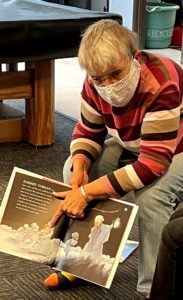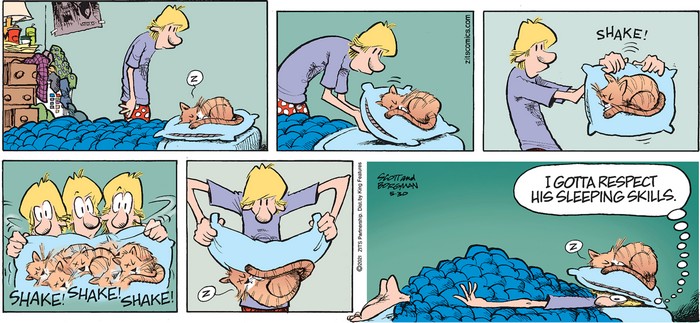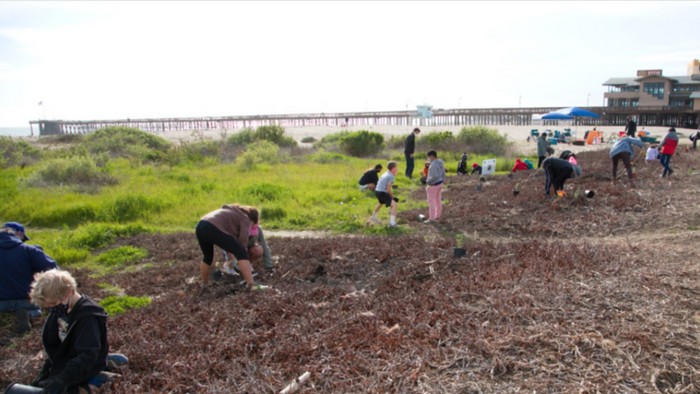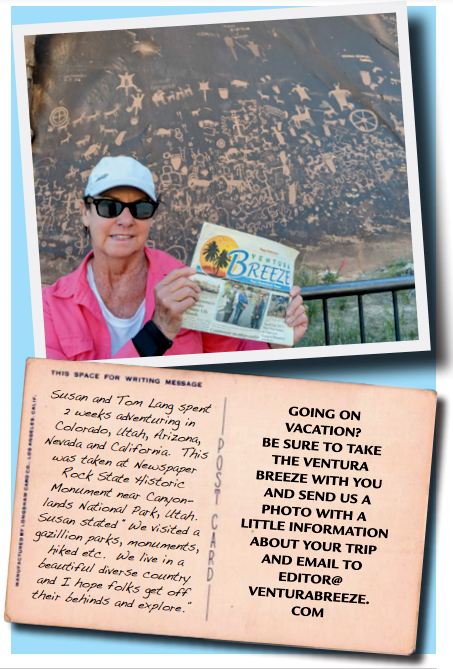 Callie is an 11-week-old Golden Retriever. She likes to play fetch and have her belly rubbed. She also loves lounging on the grass.
Callie is an 11-week-old Golden Retriever. She likes to play fetch and have her belly rubbed. She also loves lounging on the grass.
All posts by admin
Vol. 14, No. 18 – June 2 – June 15, 2021 – The Pet Page
 ∙SPAN Thrift Store is now open to the public and looking for donations of adult clothing, household items and tools if you’ve got items you no longer use.
∙SPAN Thrift Store is now open to the public and looking for donations of adult clothing, household items and tools if you’ve got items you no longer use.
SPAN Thrift Store is providing low cost spays and neuters for low income households with cats and dogs.
Two upcoming clinics in June are:
First one will be at SPAN Thrift Store parking lot 110 N. Olive St. (behind Vons on Main) on Tuesday, June 15th, and a second one on Tuesday, June 29th at Shiells Park, in the parking lot, located at 649 C St., Fillmore, 93015..
Please call to schedule an appointment (805) 584-3823.
∙One variety of Natural Balance Cat Food is being recalled for possible Salmonella contamination. The variety is Natural Balance L.I.D. Limited Ingredient Diets Green Pea & Chicken Formula Dry Cat Food that is sold in two sizes. The contamination was discovered during routine state surveillance sampling by the Minnesota Department of Agriculture. The recalling company is Natural Balance Pet Foods of San Diego, California.
People can contract Salmonella infections by touching pet food that is contaminated with the pathogen, then eating or drinking without washing their hands. They can also get sick by having contact with cat bowls, feces, or their cat’s fur, since the animal can shed the bacteria in their stool. Symptoms of Salmonella poisoning in people include a fever, nausea, vomiting, abdominal pain and cramps, and diarrhea that may be bloody. If you have been experiencing these symptoms, see your doctor.
The recalled products are both Natural Balance L.I.D. Limited Ingredient Diets Green Pea & Chicken Formula Dry Cat Food. The 5 pound bag has UPC number 2363306234, lot code 1008080 06:42N811202:20, and best if used by date 10-Mar-2022. The 10 pound bag has UPC number 2363300235, lot code 1008080 06:42N811202:20, and best if used by date 10-Mar-2022.
If you purchased this product, stop feeding it to your pet immediately. You can throw it away in a secure package in a garbage can with a tight lid. Or you can take it back to the store where you purchased it for a full refund.
Then clean and sanitize pet food bowls and any storage containers that may have held the food with a mild bleach solution. Wash with dish soap and rinse well, then dry.
∙A study from the University of Guelph suggests that a cat owner and their training methods can play a big role in preventing aggressive behavior.
Lead author Kristina O’Hanley found that the cats in the study showed less aggression if they received positive reinforcement to manage unwanted tendencies. Cats would become aggressive to their owners, other people, and other cats more often when owners made loud commands like “no!” or held them by the scruff of their neck.
Data from animal shelters was used to analyze those early experiences, and then owners were surveyed about their later experiences with the cat in the home.
“Surprisingly, we saw few effects of early management of kittens in shelters on adult cat behavior,” O’Hanley said. “Most of the effects that we saw related to how the cat was managed in the home after adoption.”
The findings show that 35% of the cats included in the study had swatted at and bitten people and that female cats were more likely to show aggression toward owners and other cats.
In homes with many cats, there was a lower risk of feline aggression toward owners and other people.
∙New study shows that pets and their owners’ diet together
Reviewed by Emily Henderson
If a pet owner is on a specific diet, chances are their dog is on it, too, a new U of G study reveals. But when it comes to a grain-free diet, owners seem to choose it more for their dogs than themselves, the study also found. It demonstrates that many variables, not just dietary habits, influence the selection of dog food.
The international Pet Food Consumer Habit Survey is the first of its kind to examine factors involved in pet owners choosing grain-free dog food in both Europe and North America.
The study found dog owners who are on gluten-free, organic or grain-free diets are likely to look for the same characteristics in the dry dog food they purchase.
Feeding their dog grain-free pet food was common among pet owners who prefer “premium” food, avoid grains or processed foods, follow vegetarian, vegan or ketogenic diets, or have strict diet routines.
Researchers surveyed 3,300 pet owners from Canada, the U.S., Germany, France and the U.K. Participants were asked where they get their information about dog food, where they buy it and the most important factors in their choices.
Just over 21% said they look for “no grain” as an attribute that influences their purchase.
The study said the pet food industry is highly influenced by human trends and what pet owners believe about nutrition. Researchers focused on pet food innovations for dogs and cats must consider consumer trends and try to supply the best food formulations for consumers’ beliefs, she said.
∙Are dogs really that good at sniffing out COVID? Another study leaves no doubt.
By Katie Camero
We don’t yet know what concerts, festivals and other large gatherings will look like after the COVID-19 pandemic is under control, but you may want to start adding dogs to the picture.
Canine presence is already normal at airports where dogs search for weapons, explosives, drugs or other dangerous materials. But they have been gradually making appearances at large events to sniff out COVID-19 following research that revealed their powerful noses could detect if a person was carrying the virus.
In its study, nine dogs were able to identify positive coronavirus samples with 96% accuracy on average after three weeks of training.
Researchers say using dogs can help catch people who are infected and don’t know it — otherwise known as asymptomatic carriers — before they spread the virus to others. This method is also cheaper than traditional testing practices. The study was published Wednesday in the journal PLOS ONE.
“This is not a simple thing we’re asking the dogs to do,” Cynthia Otto, senior author of the study and director of the University of Pennsylvania School of Veterinary Medicine Working Dog Center, said in a statement. “Dogs have to be specific about detecting the odor of the infection, but they also have to generalize across the background odors of different people: men and women, adults and children, people of different ethnicities and geographies.”
The team trained eight Labrador retrievers and one Belgian Malinois to identify whether urine or saliva samples from hospitalized adults and children were COVID-19 positive. All samples were “inactivated” to prevent the dogs from getting infected.
A “scent wheel” with 12 ports containing coronavirus positive and negative samples, as well as some controls such as gloves, paperclips, empty cans and garlic on filter paper, was presented to the dogs. If they responded to a COVID-19 positive sample, the dogs were rewarded.
Although the canines detected positive samples with high accuracy, their ability to avoid false negatives was lower, likely because of the strict study criteria, the researchers said. “If the dogs walked by a port containing a positive sample even once without responding, that was labeled a ‘miss.’”
Dogs’ noses, with about 300 million scent receptors, are exceptionally good at their jobs. In comparison, humans only have about 5 or 6 million, according to the American Lung Association, which says “a dog can even detect a teaspoon of sugar diluted in a million gallons of water (the equivalent of two Olympic sized pools).”
Vol. 14, No. 18 – June 2 – June 15, 2021 – Movie Review
Streaming Spotlight by Cindy Summers
Blue Miracle – Netflix Originals

Breeze rating from 1 to 4 palm trees, 4 being best.
“Blue Miracle” is based on the true story of a street kid guardian in Cabo San Lucas who teamed up with a washed up boat captain to try to save his orphanage by entering the world’s biggest fishing tournament, the Brisbee Black and Blue, that attracts the best teams from around the globe competing for millions in prizes
A hurricane struck the island just before the tournament, so Wayne Brisbee (Bruce McGill) changed the rules to waive the costly tournament fee to attract local fisherman to enter. Captain Wade (Dennis Quaid) was the only two time champion of the Brisbee’s Black and Blue and saw this as an opportunity for a third title, but was only allowed to enter if he teamed up with local orphanage owner Omar (Jimmy Gonzales) and several of the boys from the orphanage.
Brisbee put this together because he learned the Omar was over $100K in debt for the orphanage and that they were due to be evicted by the end of the month if they were unable to pay. Brisbee had called the bank on Omar’s behalf, but unfortunately was unable to help Omar, so saw the fishing tournament as Omar’s last chance to save the orphanage and keep the boys off the streets. Captain Wade was not happy with the arrangement, not wanting kids on the boat and especially one (Moco) that had stolen his watch earlier that week, but knew it was the only way he would be able to enter the tournament.
Papa Omar (as the boys called him) was a street kid himself, having lost his father in a boating accident while fishing when he was very young that made entering the tournament a huge challenge, though knew it was his only chance to raise the money he needed. Captain Wade sailed the boat into open waters, bait the hook with his lucky lure named after his wife and set the line for Moco who was chosen to be in the “fighting chair” the first day as the rules stated only one person can touch the pole to reel in the fish. After a few hours, the line began to reel out, so they called in they had a fish on the line only to find a large hunk of trash and seaweed.
The second day the team showed up in matching team polo shirts and Wiki was chosen to reel in the fish. Two of the boys got in an argument at the bow of the boat at the same time that a real fish got hooked on the line, but because Omar and none of the other boys knew how to swim, Captain Wade had to abandon showing Wiki how to reel in the marlin and dive in the ocean to rescue the other two boys. Unfortunately, the line snapped, the marlin got away and after hours of waiting without any success, they returned disappointed in themselves and unsure about competing the third day as Captain Wade decided it was a good time to drink his worries away.
Omar brought Captain Wade some homemade Mexican hangover food, and shared his financial troubles about the orphanage. Captain Wade was committed to helping Omar and showed up to the orphanage with a plan to hide previously caught marlin under the boat when the head out for the third day and to put it on the line when the boys were distracted thinking it could get them 3rd or maybe even 2nd place. Though Omar was conflicted, he agreed, but when it came time to fake catch the fish he dumped it over the side.
Captain Wade was distraught, but Omar knew he did the right thing and just a short time later and quite by surprise they hooked a marlin, which Omar reeled in after 40 minutes in the “fighting chair” that was big enough to actually win the tournament and save the orphanage.
Runtime: 1hr 36min
Dealing with graffiti in Ventura
We apologize for how long it took to respond to this letter (it was not an email) it ended up in a pile and was recently found. The response is long, and important so we published it as an article.
My husband and I have noticed an increase in graffiti in Ventura. Extensive continued defacing to both public walls and the 101 freeway signs, mostly along the new townhouse complex wall near the Seaward exit in nearby highway signs. It really is a shame as the cost of damage must fall on taxpayers and owners. What can we do as a community to address this? If caught, are they responsible to clean up after themselves as restitution?
Concerned Ventura citizen
Charlotte Perry-Hultgen
Here is a response from Detective Sergeant Edward Caliento, with the VPD Street Crimes Unit:
The charge for graffiti is Vandalism, the California Penal code is 594 PC. If the damage or cost of removal is less than $400 it is a misdemeanor. Over $400 is a felony. Both are punishable by time in jail, fines, and victim restitution. They could also be held liable for civil fines.
If the suspect is an adult and is found guilty, they can do jail time and be placed on probation. Probation prohibits suspects from possessing graffiti tools, being around certain people and or certain areas.
If the suspect is a juvenile and is found guilty, they might do some time in Juvenile Hall, be put on probation, or sentenced to other diversion type programs. Their parents could be liable for civil fines from the city and the victims.
If the graffiti is gang related there are additional charges that can be added.
This is what the Ventura Police Department recommends:
To report tagging/graffiti in the City of Ventura call the graffiti hotline (805) 654-7805. You can also call the Ventura Police 24/7 non-emergency number 805-650-8010. Or email [email protected] whenever you see graffiti. The line is open 24 hours per day, 7 days a week. The City’s Public Works Graffiti Removal Unit strives to remove all graffiti within 48 hours from the time we receive your call. The Ventura Police Department asks you to report these crimes through either venue, even if you’re going to clean it up yourself.
The City of Ventura is committed to promptly removing graffiti from public areas. Experience has shown that removing graffiti as soon as it occurs is the best prevention against future graffiti.
Graffiti Prevention
There are several steps you can take to prevent future graffiti tagging:
- If you see graffiti in progress, report it by calling 9-1-1. Don’t try to intervene.
- Contact the property owner whose building has been vandalized by graffiti and stress the importance of quick cleanup. Form a neighborhood group to help property owners clean up graffiti quickly.
- Prevent graffiti. Rapid removal tells vandals that people care about their place of business and neighborhood and that their work has little chance of being seen.
- Plain smooth surfaces invite graffiti. For walls, choose patterned and rough concrete surfaces or tiled or mosaic surfaces; for fences, use chain, lattice, or wooden picket fences.
- Choose paints and coating to deter graffiti. Dark colors make graffiti harder to see. Anti-graffiti coatings are available as well.
- Plant trees, shrubs, or climbing vines to restrict access to tempting walls. Plants with thorns or strong scents are good deterrents.
- Use good lighting to deter vandals from popular graffiti sites.
Kalorama Wetland Restoration Project successfully culminated with family involvement and Chumash blessings
Ventura County families planting native vegetation at Kalorama wetland by Ventura pier. Photo by Cliff Rodriguez
Youth, their families, and adult volunteers dedicated 720 hours to the restoration of the Kalorama Wetland by Ventura Pier since September, 2020. They took out non-native species that had invaded the area and learned about the benefits of native species and wetlands for our natural areas and our coast.
If you asked youth who participated in the project, on March 12, the invasive Highway Iceplant was by far the most common invasive plant they removed. Youth and adult volunteers helped decrease the area covered by iceplant from over 50% to less than 5%.
After many hard-working hours of removing invasives, we started planting this Spring! Volunteers planted 237 plants of 14 different native species, 8 of which were new to the site.
Overall, volunteers participated in 25 events! During the last Family Habitat Restoration event on March 12, 2021, Chumash elders applauded the volunteers for their effort prior to the blessing of the Kalorama Wetland site..
The Kalorama Wetland Restoration and Community Education Project involved dozens of youth and their families, community volunteers, and teachers with the support of the California State Parks Channel District and sponsorship from the State Coastal Conservancy and Southern California Wetlands Recovery Project.
In addition to the ecological benefits of the project, this project positively impacted our community by giving children and their families the opportunity to get outdoors and connect with nature, which is especially important for youth’s mental health and resilience during these times.
NAWBO celebrating BRAVA Awards
Celebrating its 21st year, BRAVA Awards, previously known as BRAVO, is the annual signature awards luncheon hosted by the Ventura County chapter of the National Association of Women Business Owners (NAWBO VC). This year’s theme is “Diversity, Resilience, Transformation: Bold Women Creating Her-story.”
Mark your calendar for Friday, June 11th, 2021 from 12:00pm to 1:30pm as NAWBO-VC shines the spotlight on outstanding businesswomen of Ventura County, honoring them for their diversity, resilience, transformation and success, which is creating a brighter future for women business owners and women-led business ventures in our community.
Do you know a bold woman creating her-story?
NAWBO-VC is currently seeking nominations for six local, outstanding and bold women in the following categories:
- Woman Business Owner of the Year
- Young Woman Entrepreneur of the Year (30 years old or younger)
- Adaptability Award
- Champion of Diversity
- Rising Star of the Year (in business less than 5 years)
- Resiliency Award
BRAVO alum include Catherine Von Burg of SimpliPhi Power, Alison Kenis of Sugar Lab Bakeshop, Emily Barany of Visionality, Breanne Cochran of The Vent Human Performance Center, Lori Volk of Lori’s Original Lemonade, Dr. Janis Shinkawa of Ohana Pet Hospital, and Dawn Dyer of Dyer Sheehan Group, Inc. Dyer brought home the prestigious NAWBO California Woman Business Owner of the Year award in 2018 and both Dyer and Shinkawa were finalists for the National Woman Business Owner of the Year presented by NAWBO in the past few years.
“The caliber of our past honorees is truly inspiring. Given the challenges we have all endured in the last year, I am thrilled that we are renaming NAWBO VC’s BRAVO awards to BRAVA in a time when women business owners have had to adapt and transform in the face of historic challenges. I believe this year’s theme accurately recognizes the resiliency of diverse women business owners now and into the future,” stated Seana-Marie Sesma, President-Elect, NAWBO Ventura County and BRAVA 2021 Chair. “I look forward to seeing who will be nominated this year.”
To nominate a bold woman, simply go to www.NAWBOVC.org and click on “BRAVA Awards.” All nominations are submitted online now through Monday, April 19, 2021. Nominees need not be NAWBO members.
The local Ventura County chapter of NAWBO is committed to strengthening the wealth creating capacity of its members while promoting economic development within the entrepreneurial Ventura County community. Additionally, the local chapter advocates for innovative and effective change in the business culture, building strategic alliances and transforming public policy for the benefit of its members. Membership is open to women sole proprietors, partners and corporate owners as well as those companies and organizations that support women-owned businesses. Learn more: www.nawbovc.org.
Vol. 14, No. 18 – June 2 – June 15, 2021 – Ojai News & Events
With an eye for plans to expand its theatrical programs, the Ojai Performing Arts Theater (OPAT) announces two new board members, Jane Seiler Weil and Michal Gaidano. Ms. Weil will become the first Chief Operating Officer (COO) for OPAT, and Ms. Gaidano will assist with special events and other functions.
“OPAT has some wonderful ideas about expanding its offerings,” said Ms. Weil, “and bringing in talent from all over Southern California. I’m excited about joining the board at such a launching point of its growth and, of course, most excited about working with Joan Kemper and learning from her.”
Many in Ojai are familiar with Jane Seiler Weil for her work with the Weil Tennis Academy, various charities, and as President of the Ojai Unified School District. She comes from theater originally with a professional reputation at leading theaters across America and overseas for production work from lighting design to stage management.
Michal Gaidano and her husband Don have been involved with theater in Ojai since they moved here in 2010.
OPAT has several projects in the wings awaiting the relaxing of COVID restrictions, including the production of “Harvey,” which was forced to close just one week before opening in 2020. Stay tuned for more news at OjaiTheater.org.
Starting in June 2021, the Humane Society of Ventura County (HSVC) in partnership with Ojai Valley Library Friends and Foundation (OVLFF) and Ventura County Libraries will begin a read-aloud program that promotes the proper treatment of animals. The program is being initially piloted with three Ojai Valley Libraries in the hope it will grow to include other Ventura County Libraries over time.
Kris Humphries, OVLFF Outreach Chair says, “The Ojai Valley Library Friends and Foundation (OVLFF) is honored to be partnering with HSVC on another literacy program to serve the Ojai Valley community. OVLFF’s sponsoring of the RedRover Readers Program is another fantastic opportunity to bring literacy, a love of reading, and humane education to our youth.”
The program was created by RedRover, a national nonprofit animal welfare organization and aligns perfectly with the missions of all the organizations involved. The new books will be used in the Ojai Valley Libraries (Oak View, Meiners Oaks, Ojai) and read aloud by HSVC Humane Educator, Angie Chupek Sagliani.
HSVC is excited about the possibilities of seeing this literacy program grow throughout Ventura County. RedRover Readers is an essential program that uses books about animals to help students practice making responsible decisions and become more aware of themselves and their communities.
Inspired by the previous collaborations, the Little Free Library and the Animal Reading Friends (A.R.F) program was built with the help of OVLFF. Now that the libraries are scheduled to open, RedRover’s Readers program will further develop the themes of literacy and empathy. The hope is that HSVC can create a culture of compassionate and mindful animal advocates.
“I hope that these partnerships that we created this month will last a long time,” says Angie Chupek Sagliani. “I feel excited to promote positive animal care through literacy.”
For more info on the Humane Society of Ventura County, visit www.hsvc.org.
Foundation Assisting Seniors debuts celebrate a Senior™ Program
The Foundation Assisting Seniors (FAS) is proud to announce the Celebrate a Senior™ program, a nationwide fundraising program to show appreciation and honor seniors across the country. Celebrate a Senior™ will directly support two national programs, HowRU™ and the Medication Reminder program which will continue to serve seniors across the U.S. at no-cost for years to come.
“We are thrilled to launch this program for seniors and their loved ones across the nation,” said Carol Chapman, president of FAS. “Now more than ever, we need to cherish our seniors and the Celebrate a Senior™ program provides an opportunity for loved ones to pay tribute to those 50 and older in their lives while supporting a service organization that provides peace of mind to seniors and their families.”
The HowRU™ program was created for seniors living alone, which provides a daily safety and check-in call to participants. The Medication Reminder Program also provides daily calls to subscribers to remind them to take their medication, both which are free and available nationwide.
The Celebrate a Senior™ program has two donation tiers. The first tier is between $25 and $99. For this tier, FAS will send the honoree a certificate signed by chair and president of FAS, includes donor and recipient names and honoree will be listed on the FAS website. The second- tier donation is any donation over $100. The honoree will receive a hand painted six-inch tile with the honoree’s name and will be mounted on the Celebrate a Senior™ wall at FAS headquarters and honoree will be listed on the FAS website.
If interested, you can donate online at FoundationAssistingSeniors.org/SeniorAppreciationProgram
Ventura Rotary Reads at Boys and Girls Club

Ventura Rotary Club members visited the Boys & Girls Club of Greater Ventura with a donation of $1,000 in new books and to read stories with children. After over a year with drastically limited opportunities to connect with students in person, Rotary Club members were excited to read with kids. The Boys & Girls Club was equally enthusiastic at having Rotary visitors, as Rotary volunteers were the first volunteers welcomed back into the club since COVID. Boys & Girls Club CEO Patti Birmingham said, “My staff and I were grinning from ear to ear with great anticipation of the joy and sense of normalcy that this would bring to our Club members!”
Masked Rotarians read with students, socially distanced, yet still engaging children in the stories, asking them questions, listening to them. Children asked for story after story leaving readers happily exhausted. “Special moments like these are magical and help build the joy of reading in kids. The benefits of reading are endless, including building a strong foundation for success in school. We all play an important role in sharing the joy of reading with young people- at home, in school, in after school programs,” said Madhu Bajaj Rotarian and organizer for Rotary Reads.
Boys & Girls Club Branch Directors selected the books they wanted for their students based on need and interest. They indicated a specific need for easy readers so they could support early readers and members who are below basic (grade level), who have been impacted the most by school closures/virtual learning. Having new books that are relevant and of interest to the children was especially meaningful as it is easier to engage them in reading.
Ventura Rotary Club President Saurabh Bajaj said, “We are happy to partner with the Boys & Girls Club and thank them for the opportunity to read with children. And, we invite our community to make time to pick up a book and read with children in their lives.”
Rotary Club of Ventura is a part of Rotary International. Rotary is a global network of over 35000 clubs and 1.2 million neighbors, friends, leaders, and problem-solvers who see a world where people unite and take action to create lasting change – across the globe, in our communities, and in ourselves. Solving real problems takes real commitment and vision. From education and peace to water, food insecurity and health, we are always working to better our world, and we stay committed to the end. VenturaRotary.org



